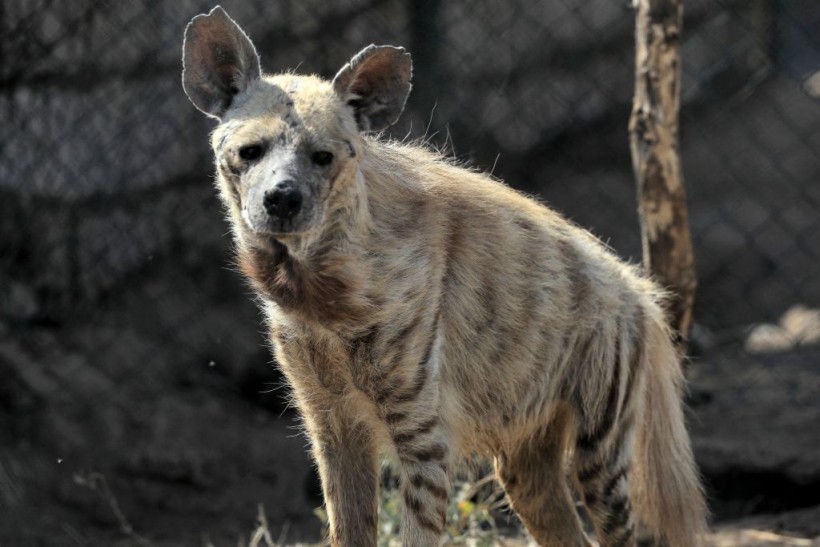Hyenas are notorious for their fierce and aggressive behavior, but they also have a social side. They live in clans of up to 80 individuals and form friendships with some of their clanmates.
But what factors influence their decision to join a fight against a rival clan? A new study by researchers from Michigan State University reveals some surprising insights into the hyena's mind.
The Risk and Reward of Collective Action
 (Photo : ASHRAF SHAZLY/AFP via Getty Images)
(Photo : ASHRAF SHAZLY/AFP via Getty Images)

The researchers observed the behavior of 74 spotted hyenas from two clans in the Hluhluwe-iMfolozi Park, South Africa.
They used GPS collars to track their movements and interactions and recorded their vocalizations to measure their social relationships.
They focused on two types of collective actions that hyenas engage in mobbing and patrolling
Mobbing is when a large group of hyenas outnumber and chase away their opponents, often resulting in injuries or deaths.
Patrolling is when a small group of hyenas explore the borders of their territory and mark their scent. Both actions are risky and costly, as they can expose hyenas to danger and competition.
However, they also have potential benefits, such as gaining access to more resources, mates, and allies.
The researchers wanted to find out what factors determine whether a hyena decides to join a mob or a patrol or stay at home. They considered three types of factors: intrinsic, extrinsic, and contextual.
Intrinsic factors are the individual characteristics of the hyena, such as its sex, age, rank, and personality. Extrinsic factors are the social characteristics of the hyena, such as its number of friends, allies, and enemies.
Meanwhile, contextual factors are the environmental characteristics of the situation, such as the time of day, the season, and the presence of other predators.
Also Read: Sleeping Teen Mauled By Hyena Loses Eye
The Role of Friendship in Hyena Decision-Making
The researchers found that the most important factor for hyena participation in collective action was friendship.
Hyenas that had more friends within their clan were more likely to join a mob but less likely to join a patrol.
The researchers suggested that friendship plays a key role in hyena decision-making. They argued that friendship provides hyenas with several advantages, such as increasing their confidence and motivation to join a mob, enhancing their communication and coordination within the mob, and reducing the risk of aggression among mob members.
Friendship also helps hyenas cope with the stress and uncertainty of mobbing, as they can rely on the support and comfort of their friends.
However, friendship also has some disadvantages for hyenas.
Hyenas that had more friends within their clan were less likely to join a patrol, as they may prefer to stay with their friends and avoid potential threats, or they may have less incentive to patrol, as they may have less need to compete for resources or mates within their clan.
The researchers also found that other factors had different effects on hyena participation in collective action, depending on the type of action.
For example, sex, rank, and personality had more influence on patrolling than on mobbing, while time of day, season, and presence of other predators had more influence on mobbing than on patrolling.
The Implications of the Study
The study is the first to show how hyenas decide whether to join a fight or not, based on a combination of intrinsic, extrinsic, and contextual factors.
It revealed that hyenas use a flexible and adaptive strategy to cope with the challenges and opportunities of their environment.
It also demonstrated that hyenas are not mindless killers, but rather sophisticated and social animals that can cooperate and communicate with each other.
The study also has implications for understanding the evolution and ecology of social behavior in other animals, including humans.
It suggested that friendship is not only a source of happiness and well-being but also a powerful and complex force that shapes the behavior and outcomes of groups.
Moreover, it showed that friendship can have both positive and negative effects, depending on the situation and the goals of the individuals and the group.
Related article: Siberian Woolly Rhino DNA From Ice Age Found in Fossilized Poop of Ancient Hyena
© 2024 NatureWorldNews.com All rights reserved. Do not reproduce without permission.



![Climate Change is Reducing Dust Levels Worldwide as Arctic Temperature Warms [Study]](https://1471793142.rsc.cdn77.org/data/thumbs/full/70320/280/157/50/40/climate-change-is-reducing-dust-levels-worldwide-as-arctic-temperature-warms-study.jpg)

